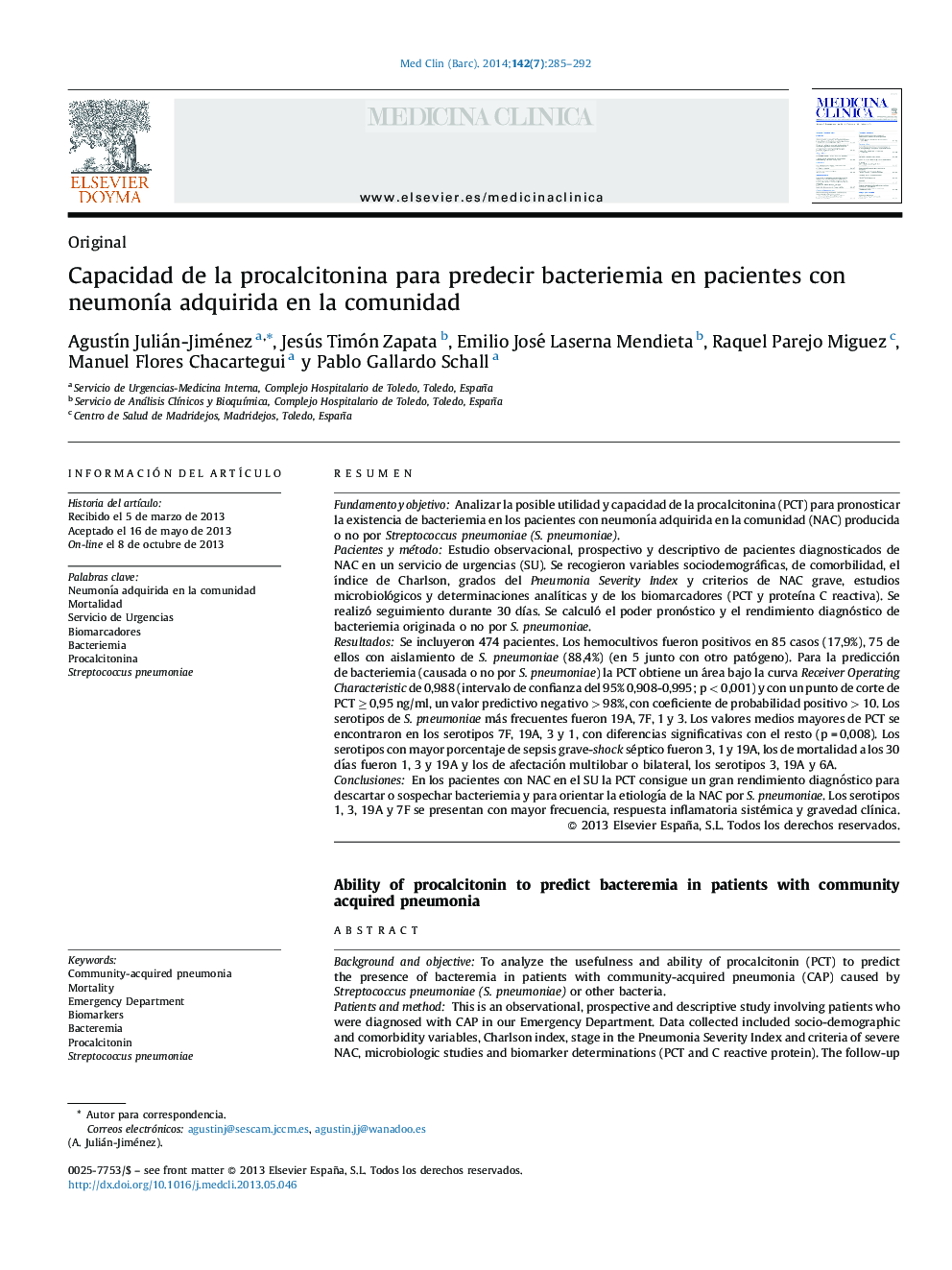| کد مقاله | کد نشریه | سال انتشار | مقاله انگلیسی | نسخه تمام متن |
|---|---|---|---|---|
| 3800448 | 1244636 | 2014 | 8 صفحه PDF | دانلود رایگان |

ResumenFundamento y objetivoAnalizar la posible utilidad y capacidad de la procalcitonina (PCT) para pronosticar la existencia de bacteriemia en los pacientes con neumonía adquirida en la comunidad (NAC) producida o no por Streptococcus pneumoniae (S. pneumoniae).Pacientes y métodoEstudio observacional, prospectivo y descriptivo de pacientes diagnosticados de NAC en un servicio de urgencias (SU). Se recogieron variables sociodemográficas, de comorbilidad, el índice de Charlson, grados del Pneumonia Severity Index y criterios de NAC grave, estudios microbiológicos y determinaciones analíticas y de los biomarcadores (PCT y proteína C reactiva). Se realizó seguimiento durante 30 días. Se calculó el poder pronóstico y el rendimiento diagnóstico de bacteriemia originada o no por S. pneumoniae.ResultadosSe incluyeron 474 pacientes. Los hemocultivos fueron positivos en 85 casos (17,9%), 75 de ellos con aislamiento de S. pneumoniae (88,4%) (en 5 junto con otro patógeno). Para la predicción de bacteriemia (causada o no por S. pneumoniae) la PCT obtiene un área bajo la curva Receiver Operating Characteristic de 0,988 (intervalo de confianza del 95% 0,908-0,995; p < 0,001) y con un punto de corte de PCT ≥ 0,95 ng/ml, un valor predictivo negativo > 98%, con coeficiente de probabilidad positivo > 10. Los serotipos de S. pneumoniae más frecuentes fueron 19A, 7F, 1 y 3. Los valores medios mayores de PCT se encontraron en los serotipos 7F, 19A, 3 y 1, con diferencias significativas con el resto (p = 0,008). Los serotipos con mayor porcentaje de sepsis grave-shock séptico fueron 3, 1 y 19A, los de mortalidad a los 30 días fueron 1, 3 y 19A y los de afectación multilobar o bilateral, los serotipos 3, 19A y 6A.ConclusionesEn los pacientes con NAC en el SU la PCT consigue un gran rendimiento diagnóstico para descartar o sospechar bacteriemia y para orientar la etiología de la NAC por S. pneumoniae. Los serotipos 1, 3, 19A y 7F se presentan con mayor frecuencia, respuesta inflamatoria sistémica y gravedad clínica.
Background and objectiveTo analyze the usefulness and ability of procalcitonin (PCT) to predict the presence of bacteremia in patients with community-acquired pneumonia (CAP) caused by Streptococcus pneumoniae (S. pneumoniae) or other bacteria.Patients and methodThis is an observational, prospective and descriptive study involving patients who were diagnosed with CAP in our Emergency Department. Data collected included socio-demographic and comorbidity variables, Charlson index, stage in the Pneumonia Severity Index and criteria of severe NAC, microbiologic studies and biomarker determinations (PCT and C reactive protein). The follow-up was carried out during 30 days to calculate the predictive power and the diagnostic performance for bacteremia caused or not by S. pneumoniae.ResultsFour hundred and seventy-four patients were finally included in the study. Blood cultures were positive in 85 individuals (17.9%) and S. pneumoniae was identified as the responsible pathogen in 75 of them (88.4%) (in 5 cases together with another agent). The area under the Receiver Operating Characteristic curve for PCT to predict bacteremia (caused by S. pneumoniae or not) was 0.988 (95% confidence interval 0.908-0.995; P < .001) and, considering a cut-off value ≥ 0.95 ng/mL, the negative predictive value and the positive likelihood ratio were > 98% and > 10, respectively. The most frequently isolated serotypes of S. pneumoniae were 19A, 7F, 1 and 3. The highest mean levels of PCT were found in serotypes 7F, 19A, 3 and 1, which showed statistically significant differences with regard to the others serotypes considered (P = .008). Serotypes associated with the highest percentage of severe sepsis-septic shock, 30-days mortality and multi-lobe or bilateral affection were 3, 1 and 19A; 1, 3 and 19A; and 3, 19A and 6A, respectively.ConclusionsPCT had a remarkable diagnostic ability to discard or suspect bacteremia and to guide the etiology of CAP caused by S. pneumoniae. Serotypes 1, 3, 19A and 7F showed greater frequency, systemic inflammatory response and clinical severity.
Journal: Medicina Clínica - Volume 142, Issue 7, 7 April 2014, Pages 285–292